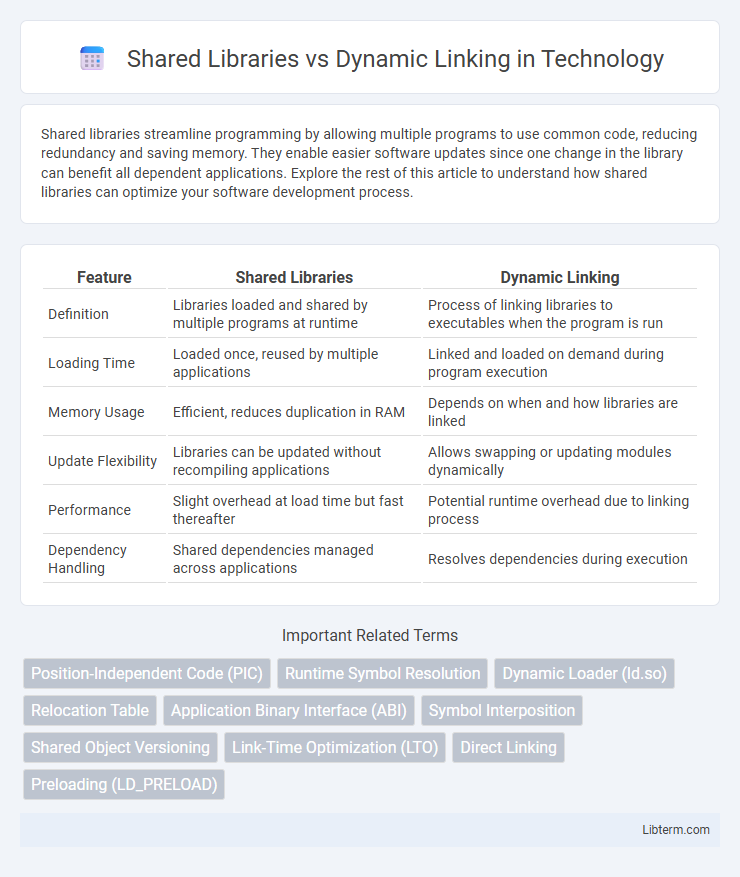Shared libraries streamline programming by allowing multiple programs to use common code, reducing redundancy and saving memory. They enable easier software updates since one change in the library can benefit all dependent applications. Explore the rest of this article to understand how shared libraries can optimize your software development process.
Table of Comparison
| Feature | Shared Libraries | Dynamic Linking |
|---|---|---|
| Definition | Libraries loaded and shared by multiple programs at runtime | Process of linking libraries to executables when the program is run |
| Loading Time | Loaded once, reused by multiple applications | Linked and loaded on demand during program execution |
| Memory Usage | Efficient, reduces duplication in RAM | Depends on when and how libraries are linked |
| Update Flexibility | Libraries can be updated without recompiling applications | Allows swapping or updating modules dynamically |
| Performance | Slight overhead at load time but fast thereafter | Potential runtime overhead due to linking process |
| Dependency Handling | Shared dependencies managed across applications | Resolves dependencies during execution |
Introduction to Shared Libraries and Dynamic Linking
Shared libraries are collections of pre-compiled code loaded into memory during program execution, enabling multiple applications to use common functions without duplication. Dynamic linking refers to the process where these shared libraries are linked to an application at runtime rather than compile-time, allowing updates and memory savings. This method enhances modularity, reduces executable sizes, and facilitates easier maintenance across software systems.
Key Differences Between Shared Libraries and Dynamic Linking
Shared libraries are collections of precompiled routines that multiple programs can use simultaneously, reducing memory usage and disk space. Dynamic linking refers to the process where these shared libraries are linked to an executable at runtime rather than at compile time, enabling updates to the library without recompiling dependent applications. Key differences include the timing of symbol resolution, with static linking resolving symbols at compile time and dynamic linking resolving them at load or runtime, and shared libraries support dynamic linking by providing reusable code modules loaded when needed.
How Shared Libraries Work
Shared libraries work by loading a single copy of common code into memory, which multiple programs can access simultaneously, reducing memory usage and disk space. When a program uses dynamic linking, it references shared library functions that the operating system resolves at runtime through a procedure linkage table or dynamic symbol resolution. This process allows for updates to shared libraries without recompiling dependent programs, improving modularity and maintainability.
How Dynamic Linking Operates
Dynamic linking operates by deferring the resolution of external library references until program load or runtime, allowing executable files to remain smaller and updated independently from the libraries they use. The operating system loader maps shared library code into the process's address space and resolves symbol addresses through the dynamic linker, facilitating efficient memory usage and modular software deployment. This process enables multiple programs to share a single copy of a library, reducing redundancy and enabling easier application updates without recompilation.
Advantages of Using Shared Libraries
Shared libraries significantly reduce memory usage by allowing multiple programs to share a single copy of the library code, which enhances system efficiency. They facilitate easier updates and maintenance since the library code can be updated independently without recompiling dependent applications. This dynamic linking approach also supports modular programming, enabling faster program startup and smaller executable file sizes.
Benefits of Dynamic Linking
Dynamic linking reduces executable file size by loading shared libraries into memory only when needed, optimizing system resource usage. It enables automatic updates and security patches since libraries are centrally managed, eliminating the need to recompile or redistribute dependent applications. This approach enhances modularity and flexibility, allowing multiple programs to share common code efficiently and improving overall system performance.
Performance Comparison: Shared Libraries vs Dynamic Linking
Shared libraries optimize memory usage by allowing multiple programs to share a single copy of common code, reducing overall system resource consumption compared to static linking. Dynamic linking introduces a slight runtime overhead during symbol resolution and loading but offers faster application startup times and easier updates since libraries are linked on demand. Performance differences between shared libraries and dynamic linking are typically negligible in modern systems, with dynamic linking favored for efficient maintenance and modular software design.
Security Considerations and Risks
Shared libraries and dynamic linking reduce executable file sizes and improve modular updates but introduce security risks such as code injection and dependency attacks. Attackers can exploit vulnerabilities in shared libraries through techniques like DLL hijacking, leading to unauthorized access or privilege escalation. Ensuring secure loading paths, implementing code signing, and maintaining updated shared libraries are critical to mitigating these security threats.
Real-World Use Cases and Examples
Shared libraries enable multiple programs to use common code simultaneously, reducing memory usage and simplifying updates, as seen in operating systems like Linux where libc is shared across applications. Dynamic linking allows applications to load and bind libraries at runtime, facilitating modular software like web browsers (e.g., Firefox) that can load plugins or components on demand. Real-world use includes Windows DLLs for shared system resources and Android APKs employing dynamic linking for efficient app performance and modular updates.
Choosing the Right Approach: Best Practices
Choosing between shared libraries and dynamic linking depends on the application's performance, memory usage, and update requirements. Shared libraries optimize memory by allowing multiple programs to use a single copy of a library, improving load times and reducing overall disk space. Dynamic linking offers flexibility for updates and patches without recompiling executables, making it ideal for modular applications requiring frequent maintenance.
Shared Libraries Infographic

 libterm.com
libterm.com